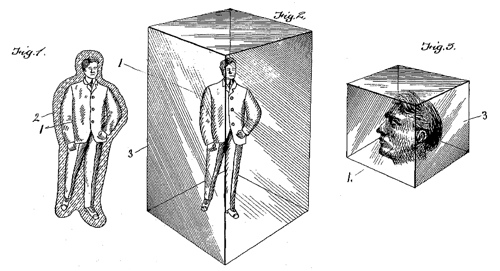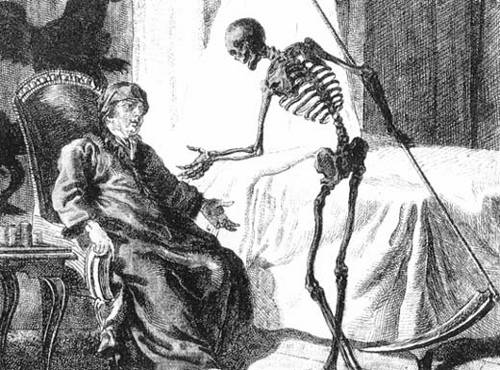Here lies the body of Thomas Woodhen,
The most loving of husbands and amiable of men.N.B.–His name was Woodcock, but it wouldn’t rhyme.
Erected by his loving widow.
From Epitaphiana: or, The Curiosities of Churchyard Literature, 1873.
Here lies the body of Thomas Woodhen,
The most loving of husbands and amiable of men.N.B.–His name was Woodcock, but it wouldn’t rhyme.
Erected by his loving widow.
From Epitaphiana: or, The Curiosities of Churchyard Literature, 1873.

Another great man who lost his head after death: René Descartes. The French philosopher died in Sweden in 1650 and was interred there for 16 years. When his body was exhumed for return to France, the ambassador appropriated his right index finger (“the instrument of immortal writing”) and, apparently inspired, one of the Swedish guards took the skull, engraving on it “Descartes’ skull, taken and carefully kept by Israel Planstrom when the body was sent to France and hidden since that time.”
The skull bounced around Europe for 150 years, with various owners carving their names on it; it was discovered missing only when the coffin was opened again in 1819. A Swedish chemist, no doubt rolling his eyes, tracked it down and returned it to the French academy.
Bonus beheading: When Sir Walter Raleigh was executed in 1618, his head was embalmed and given to his wife. She kept it until her death in 1647, when it was returned to Raleigh’s tomb in Westminster Abbey.
For those keeping score, our list now includes Descartes, Raleigh, Joseph Haydn, Oliver Cromwell, Jeremy Bentham, and Albert Einstein. Keep ’em coming.
(Thanks, Sarah.)
Terrified of being buried alive, Hannah Beswick left a bequest to her family physician, Charles White, on condition that she be kept above ground for 100 years. So when she died in 1758, White added her embalmed corpse to his collection of anatomical preparations, and every day he and two witnesses raised the veil and confirmed that she was indeed dead.
But 100 years is a long time, and the observations passed from reverent to perfunctory and finally absurd. The doctor eventually stored the mummy in an old grandfather clock, whose face he would open once a year to check on the patient, and when he died Miss Beswick was actually put on display in the entrance hall of the Manchester Natural History Museum, from which, wrote Edith Sitwell, the “cold dark shadow of her mummy hung over Manchester in the middle of the eighteenth century.”
Only in 1868, 110 years after her death, did the secretary of state issue an order for Hannah’s burial, and she was interred in an unmarked grave. Perhaps by that time she was glad of the rest.
See also My Dearly Departed.
Conclusion of an epitaph on a tombstone in eastern Tennessee:
She lived a life of virtue, and died of cholera morbus, caused by eating green fruit, in the full hope of a blessed immortality, at the early age of twenty-one years, seven months, and sixteen days. Reader, go thou and do likewise.
From Epitaphiana: or, The Curiosities of Churchyard Literature, 1873.
The Hereford Times of November 16, 1901, reprints the following case from Pauillac. A Madame Bobin arrived there on board the steamer ‘La Plata,’ from Senegal. She was supposed to be suffering from yellow fever, and was transferred to the Lazaret by order of the officer of health. There she became worse, and apparently died. The body became rigid, and the face ashen and corpse-like, and in that condition she was buried. The nurse, however, had noticed that the body was not cold, and that there was tremulousness of the muscles of the abdomen, and expressed the opinion that Madame Bobin was prematurely buried. On this being reported to Madame Bobin’s father, he had the body exhumed, when it was found that a child had been born in the coffin. The autopsy showed also that Madame Bobin had not contracted yellow fever, and had died from asphyxiation in the coffin. A suit was begun against the health officers and the prefect, which resulted in a verdict for £8,000 damages against them.
— William Tebb, Premature Burial and How It May Be Prevented, 1905

Thanks to Joseph Karwowski, you’ll never have to say goodbye to your Uncle Julius. Patented in 1903, Karwowski’s “method of preserving the dead” hermetically encases the corpse in a block of transparent glass to prevent decay and maintain a lifelike appearance.
Bonus: “In Fig. 3 I have shown the head only of the corpse as incased within the transparent block of glass, it being at once evident that the head alone may be preserved in this manner, if preferred.”
This is the Roundhay Garden Scene, the earliest surviving motion picture, shot in 1888 in the Leeds garden of Joseph and Sarah Whitley.
The scene is only 2 seconds long, but it seems to have conveyed a queer curse. Sarah died only 10 days after the shoot; director Louis Le Prince vanished from a French train two years later; and actor Alphonse Le Prince was found dead of a gunshot in 1902. There’s a novel in here somewhere.
Monument inscription, Whitby churchyard, North Yorkshire:
Here lies the bodies of FRANCIS HUNTRODDS and MARY his Wife who were both born on the same Day of the Week Month and Year (viz) Septr ye 19th 1600 Marry’d on the day of their Birth and after having had 12 Children born to them died Aged 80 Years on the same day of the year they were born September ye 19th 1680 the one not above five hours before ye other.
Husband, and Wife that did twelve Children bear,
Dy’d the same day; alike both aged were,
Bout eighty years they liv’d, five hours did part,
(Ev’n on the marriage day) each tender heart.
So fit a match, surely, could never be
Both, in their lives, and in their deaths agree.

Leinbach had discovered a proof that there really is no death. It is beyond question, he had declared, that not only at the moment of drowning, but at all the moments of death of any nature, one lives over again his past life with a rapidity inconceivable to others. This remembered life must also have a last moment, and this last moment its own last moment, and so on, and hence, dying is itself eternity, and hence, in accordance with the theory of limits, one may approach death but can never reach it.
— Arthur Schnitzler, Flight Into Darkness, 1931

As he lay dying in 1635, Lope de Vega asked whether the end was at hand. Assured that it was, he murmured, “All right, then, I’ll say it. Dante makes me sick.”